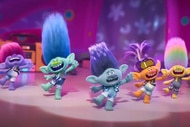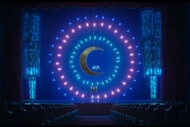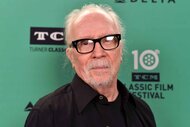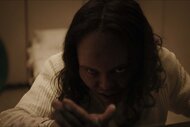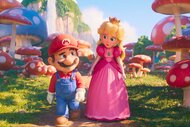Create a free profile to get unlimited access to exclusive videos, sweepstakes, and more!
The History of "The Hanging Tree" Song in The Hunger Games Saga
What's the origin of that seminal song from The Hunger Games Saga?

If you've watched The Hunger Games Saga (airing on SYFY this month), there are two distinct aural markers that signify the films: the trill of the Mockingjay's call and the haunting folk song, "The Hanging Tree." The latter is presented by author Suzanne Collins in the book and film canon as a song important to Panem history, originating from District 12, the home of Katniss Everdeen (Jennifer Lawrence).
A contemplative ballad about murders committed upon its branches, "The Hanging Tree" in the mouth of Katniss eventually becomes an anthem of rebellion for the District uprising that's core to the last two films, The Mockingjay Part I and Part II. Of course the song exists, as its featured in a key scene in The Mockingjay Part I and in the prequel novel and film, The Hunger Games: The Ballad of Songbirds and Snakes. But how did it come to be?
For More on The Hunger Games:
Breaking Down the Characters and Canon that Connect The Hunger Games Saga
The 10 Greatest Moments from The Hunger Games Saga
5 Things You Need to Know About The Hunger Games Canon
The Origin of The Hunger Games Song, "The Hanging Tree"
Collins introduces "The Hanging Tree" song into the canon of her mythology in the first The Hunger Games book. The song reflects the Appalachian-type roots of District 12, home of the Everdeen family. Katniss learns the song from her father, who sang it to her as a child. After his death, Katniss' mother forbids her daughters from singing it anymore.
The song's dark themes are meant to reflect the oppression of the Capitol and how the people of the District endure its authoritarian style of justice. The lyrics were written by Collins in prose, however, a melody wasn't associated with the lyrics until the making of the films. For the third film in the saga, The Hunger Games: Mockingjay – Part 1, Collins' lyrics were used as the basis for the song written by composer James Newton Howard and songwriters Jeremiah Fraites and Wesley Schultz of the band The Lumineers.
"The Hanging Tree" was included in the third film's official soundtrack with vocals performed by Lawrence. She performed the song live on set for a scene in the film where Katniss is asked to sing the song, and its captured on film by her Star team members. Then District 13 President Alma Coin (Julianne Moore) and her propaganda expert, Plutarch Heavensbee (Philip Seymour Hoffman) broadcast the song to all of Panem, where it becomes a solemn rallying cry for all of the rebels.
Lucy Gray's creation of "The Hanging Tree"
Interestingly, "The Hanging Tree's" origin story gets fleshed out in the prequel book and film, The Hunger Games: The Ballad of Songbirds and Snakes. Sixty-four years before the events of Katniss Everdeen's life, the prequel reveals that the song was composed by Lucy Gray Baird (Rachel Zegler), the first Hunger Games victor from District 12.
As the winner of the 10th games, Baird returns to her District and it becomes one of her signature songs. She writes it after witnessing the execution of Arlo Chance at a District's hanging tree. Chance is accused of killing two Peacekeepers and a coal mine boss, which explains the three people referenced in the lyrics. The song then takes on a deeper, darker meaning when Baird discovers that Coriolanus Snow has killed three people too.
Catch The Hunger Games Saga airing this month on SYFY!



